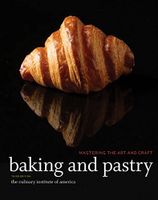Advertisement
Baked Custards
Appears in
By Culinary Institute of America
Published 2015
A simple baked custard calls for blending eggs, milk or cream, and sugar and baking until set. Savory custards eliminate the sugar.
- Heat the milk or cream and some of the sugar, stirring until the sugar is completely dissolved. Milk or cream is the most common base for custard; heavy cream lends a richer flavor and mouth feel than milk. Mascarpone, cream cheese, or another soft fresh cheese may be substituted for part of the cream to yield a richer and firmer result. Less fat will yield a firmer custard.
- Add the flavorings at this point and steep, if necessary, off the heat and covered, long enough for them to impart a rich, full flavor. Vanilla beans, coffee, tea, and spices are commonly used as flavorings in baked custards. Vanilla and coffee beans, whole or ground, as well as tea, may be left to steep in the mixture and then strained out once infused. Other flavorings such as extracts, liquor, ground spices may be added at this point.
- Bring the mixture to a boil.
- Blend the eggs and the remaining sugar to make a liaison. The proportion of eggs also may be varied, as may the choice of whole eggs, yolks only, or a combination. Use extra yolks along with whole eggs for a softer custard. Use only egg yolks for a richer, creamier mouthfeel. Use all whole eggs to give more structure to a custard that is to be unmolded.
- Whisking constantly, temper the liaison by streaming in the hot milk. Be careful not to aerate the mixture by overwhisking. Slowly incorporating the milk into the liaison of egg and sugar is done to prevent the egg from curdling.
- You can add the rest of the hot milk more rapidly without cooking the egg mixture.
- Pour the mixture through a fine-mesh strainer. This step ensures that anything that would interfere with the texture is removed from the final custard mixture, including any bubbles that may form at the surface of the custard.
- Fill the molds with the custard. The molds can be coated with a light film of softened butter if you intend to unmold the custard. This coating will help the custard to be freed without cracks or damage its integrity once it is later removed from the mold.
- Bake the custard in a hot water bath. Using a hot water bath ensures even baking through gentle heat at a constant temperature. Hot water baths also prevent the formation of a crust on the surface of the custard, as well as any rapid expansion that would result in cracks on the custard’s surface. You may also bake them in a convection oven at a low temperature, around 200°F.
- To check the custard for doneness, shake the mold gently. When the ripples on the surface move back and forth, rather than in concentric rings, the custard is properly baked.
- Allow the custards to cool completely and refrigerate to store.


